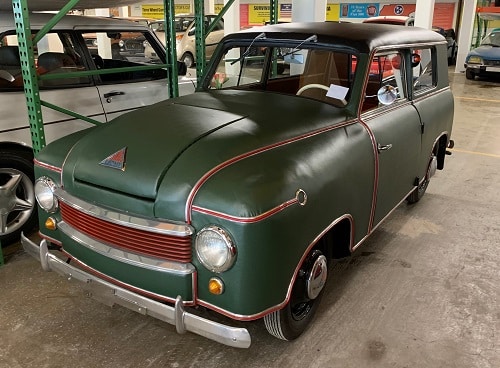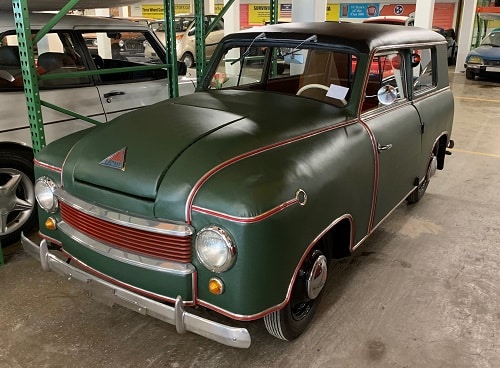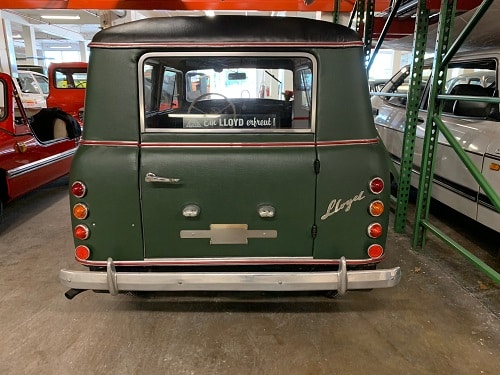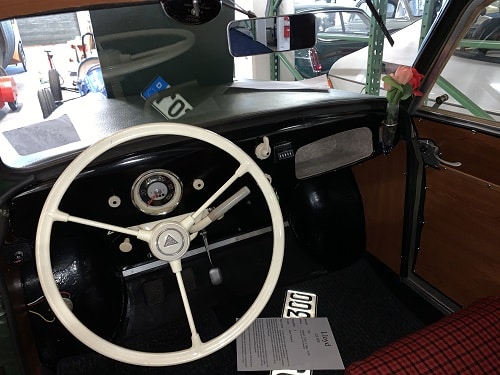
Lloyd LP 300- 1951

The origins of Germany’s Lloyd go back to 1906. Norddeutsche Automobil und Motoren GmbH (North German Automobile and Engines) was a German automobile manufacturer, created and owned by shipping company, Norddeutsche Lloyd. In 1906 it signed an agreement to build Kriéger-type electric vehicles which were sold under the name Lloyd. In 1908, automobile engineer Joseph Vollmer joined the company and designed their first gas-engine car. The 14/35 PS had a 3685cc 4-cylinder engine, but few were made. In 1914, the company merged with Hansa to become Hansa-Lloyd Werke AG. Most of their cars were sold as Hansa, with the Hansa-Lloyd name attached to commercial vehicles only. The company was integrated into the Borgward group after the purchase of Hansa by successful industrialist Carl F. W. Borgward in 1929, and Lloyd was dropped as a marque.
After WWII, during the demand for affordable cars, Borgward wanted to expand the range of medium-priced cars being produced. He revived Lloyd in this quest, and in April, 1950 the small LP 300 saloon was introduced. It was a simple, compact four-seater car with a 293cc vertical-twin two-stroke, developing 10bhp. What was significant about the Lloyd’s powertrain is that it was the first time a transverse front-mounted engine used an inline transmission, as is now the norm on almost all modern FWD cars.
Lloyds were constructed using a tubular steel chassis with crossmembers and a platform of sheet steel. Given the lack of steel in the post-war era, Lloyd bodies were made of plywood and covered in kunstleder—vinyl covered fabric. Use of these materials avoided a costly investment in heavy presses and complex dies. The windows slid open horizontally which avoided the need for bulky winder mechanisms, also cutting cost. All of this economy gained the LP 300 the affectionate nickname “Leukoplastbomber” or “Band-Aid” bomber.
Surprisingly, sales were fairly strong in the U.S. market. In its home market, it ranked third, behind Volkswagen and Opel. At DM 3,334 ($795), it was cheaper than the VW Beetle by 25%. The only cheaper cars were open two-seaters such as the Champion and Kleinschnittger, which were not serious competitors. From 1951 onwards, the LP 300 was also available as a convertible, coupe, estate wagon and minivan. In 1962, as Borgward’s alleged financial problems mounted, the Lloyd marque went with it, though a remarkable 300,000 total Lloyd models had been sold by that time.
Specifications:
Manufacturer: Carl F. W. Borgward Gmbh
Country of Origin: West Germany
Drivetrain Configuration: Front-mounted, front-wheel drive
Engine: Air-cooled, 293cc twin cylinder, two-stroke
Transmission: Manual 3-speed unsynchronized gearbox, driving front wheels by chain
Top Speed: 46 mph
Years of Production: 1950 to 1952
Number Produced: 18,087 (Lloyd LP 300s)
Original Cost: DM 3,334 ($795)


